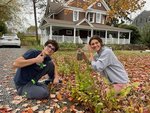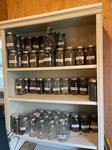On a cold and cloudy Veterans Day, local high schoolers spent their morning harvesting seeds on environmental activist Marshall Brown’s home garden in Sayville.
Brown, who is the founder …
This item is available in full to subscribers.
We have recently launched a new and improved website. To continue reading, you will need to either log into your subscriber account, or purchase a new subscription.
If you had a login with the previous version of our e-edition, then you already have a login here. You just need to reset your password by clicking here.
If you are a current print subscriber, you can set up a free website account by clicking here.
Otherwise, click here to view your options for subscribing.
Please log in to continue |
|


On a cold and cloudy Veterans Day, local high schoolers spent their morning harvesting seeds on environmental activist Marshall Brown’s home garden in Sayville.
Brown, who is the founder and executive director of Long Island Conservancy, a not-for-profit whose mission is “…to change that fate for our local animals by returning our local plants, by working with local groups in every community to help them tackle invasives and to recreate the local habitats…,” hosted the students in an effort to educate younger people about a “great return to native plants.”
By harvesting native wildflower plants (who thrive on our naturally sandy soil), a stockpile of seeds is compiled to help those who wish to transition to a more environmentally friendly lawn and garden on Long Island.
“We harvested enough seeds for over 10 acres of land,” said Brown.
With the recent lack of rainwater this summer season and monoculture lawns across the community going brown, Brown advised that this unsightly landscaping would not be an issue with native plants, as they will “find their own water” and “would not need fertilizer to help them along.”
More importantly, the harvesting session was held to plant the seed of “local stewardship” in the next generation of gardeners.
Some of the plants included purple cone flower, astera, goldenrods, and milkweed.
Seeds were placed into mason jars and held in a climate-appropriate space, awaiting usage.
Brown insists there is no time to waste to get back to native planting, as climate change and once-in-a-century storms continue to batter the South Shore of Long Island.
“We’ve landscaped it to death. We need to restore natural habitat where we can. We are just coming into an awareness of our soil biome. The soil is exhausted and unhealthy,” said Brown.
Hoping to make the argument for native planting through the beauty of hardy, Long Island-tested blooms, Brown has completely replanted his lawn to reflect all sustainable varieties of life.
“We’re fighting to save some local species,” said Brown, “and schools are a great place to do that because of all the property they have.”
During the course of the harvesting session, one student came upon an egg sac that Brown said had to be destroyed, along with others, because it was a Chinese praying mantis whose pestilence destroys the plants, which are feasted upon by monarch caterpillars.
“It was a great way to introduce the cycle of life, of stewardship, to students who can be the caretakers of our plants,” said Brown.
Comments
No comments on this item Please log in to comment by clicking here